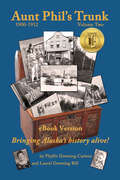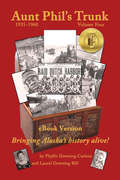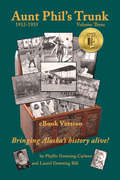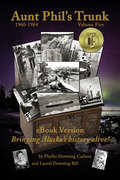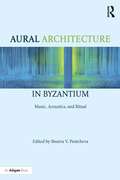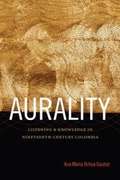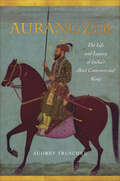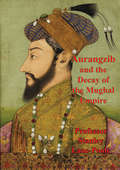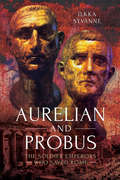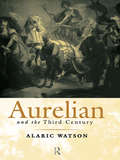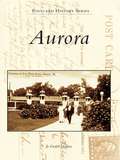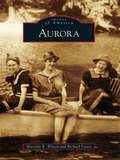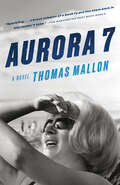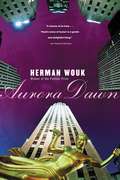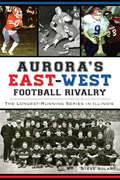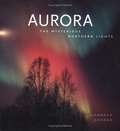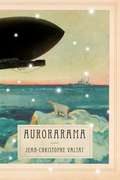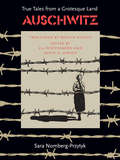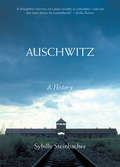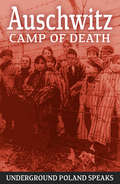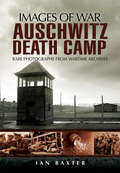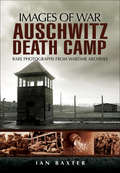- Table View
- List View
Aunt Phil's Trunk: Bringing Alaska's history alive!, Vol 2 (Aunt Phil's Trunk : Volume Two Ser.)
by Laurel Downing BillAdventurers, crooks and lawmen flooded into Alaska following the Klondike Gold Rush of 1898. Towns like Nome, Fairbanks and Valdez blossomed on the tundra and soon filled with merchants, madams, miners and more. In this second book of the Aunt Phils Trunk series, readers are taken on a journey of discovery when prospectors stumbled across gold in the Iditarod, men summited the mighty mountain called Denali, and the people of Kodiak survived the largest volcanic eruption in North American history. Readers from ages 9 to 99 will love this collection of stories and more than 300 historical photographs that highlight Alaska s colorful past from 1900 to 1912.
Aunt Phil's Trunk: Bringing Alaska's history alive!, Vol 4 (Aunt Phil's Trunk : Volume Four Ser.)
by Laurel Downing BillAuthor Laurel Downing Bill continues to bring Alaska history alive in “Aunt Phil’s Trunk Volume Four.” Following in the fast-paced and entertaining footsteps of the previous three volumes, Volume Four captures the essence of life in Alaska between 1935 and 1960. Its easy-to-read nonfiction short stories and more-than 350 historical photographs highlight major events of World War II, the Cold War era and Alaska’s struggle for statehood. <P><P> When the Japanese bombed Pearl Harbor on Dec. 7, 1941, the military presence in Alaska was woefully inadequate. And within six months, the Japanese bombed Alaska’s Dutch Harbor, occupied two islands in the Aleutian Chain and had eyes toward an invasion of America. <P> As the U.S. military began building bases across Alaska, it also organized Alaska’s Native people into a territorial guard that became known as the “Eskimo Scouts.” These men and women routinely patrolled more than 2,000 miles of coastline and 200,000 square miles of tundra to make sure the enemy did not advance. <P> World War II brought big defense dollars north, which helped bolster Alaska’s economy. It also brought a secret Russian mission to Fairbanks, interment of Aleut people in the foreign landscape of Southeast Alaska and a wide proliferation of tuberculosis. <P> During the Cold War era, Alaska saw another increase of money and people into the Last Frontier. This period of its colorful past also generated stories of heroic Alaska Airlines flights for freedom, Alaska Natives’ battles against discrimination and the blossoming of Anchorage into a jewel on the tundra. <P> The last section of this action-packed volume features Alaska’s 91-year-old struggle for statehood. Tales of tenacity, hope and determination fill these pages. They also showcase many of the movers and shakers of days gone by, Alaska’s first elected governor and the discovery of crude oil that tipped the balance toward statehood. <P> Critics and readers alike are saying “Aunt Phil’s Trunk” is outstandingly well produced, exceptionally informative and heaps of fun to read.
Aunt Phil's Trunk: Bringing Alaska's history alive!, Vol. 3 (Aunt Phil's Trunk : Volume Three Ser.)
by Laurel Downing BillAunt Phil's Trunk Volume Three entertains readers as they travel through Alaska's history from 1912 to 1935. This book of nonfiction short stories highlights the pioneering spirit of early Alaskans as they enter a new era as a territory of the United States. As with the first two books, Volume Three is filled with close to 350 historical photographs. <P> <P> Downing Bill weaves page-turning narratives. Readers follow along as men with axes, hammers and mauls pound a path through the vast Alaska wilderness to lay railroad tracks that connect the deep-water port of Seward in the south to the territory's interior town of Fairbanks in the north. Through the stories in this volume, readers watch a railroad construction town grow out of the tundra to become Anchorage, the largest city in Alaska. <P> Volume Three also shares stories about epidemics and disasters, including the Great Sickness of 1918, the sinking of the steamship Princess Sophia in Southeast Alaska and the incredible diphtheria serum run in 1925 when brave mushers and their tenacious dogs saved the town of Nome from certain death. <P> This book shines a light on early aviators who blazed new trails through Alaska skies, how the Alaska Native people struggled for recognition and how farmers from America's Midwest carved out an agricultural community in the wild Matanuska Valley. It ends with the fatal airplane crash of humorist Will Rogers and aviator Wiley Post near Barrow in 1935.
Aunt Phil's Trunk: Bringing Alaska's history alive!, Vol. 5
by Laurel Downing BillAunt Phil's Trunk Volume Five features dozens of short stories and hundreds of historical photographs that share the history of Alaska from 1960 to 1984. This fifth book in the Alaska history series highlights the first 25 years of statehood when the optimistic citizens of the Great Land created a government from scratch in just a few years and dealt with many challenges. Aunt Phil s Trunk Volume Five shares firsthand accounts of survivors who experienced the 1964 Good Friday earthquake and the devastating tsunamis that followed that 9.2 temblor. It also features stories about the discovery of black gold on the North Slope in the late 1960s, and how Alaska s Native people fought for their land and won the largest settlement ever granted Native Americans. That agreement cleared the way for oil companies to build an 800-mile pipeline through some of the most rugged and remote country in the world during the 1970s.
Aupnivaisik Bharat Me Sanskrtik Aur Vichardharamatmak Sangharsh
by K. N. PanikkarThe book is an honest endeavour to find how the Indians under colonial rule established an equation with their past and present. A time in Indian history which is famously called creative self inspection. Definitely a book which should be read extensively by readers of Indian history.
Aural Architecture in Byzantium: Music, Acoustics, and Ritual
by Bissera V. PentchevaEmerging from the challenge to reconstruct sonic and spatial experiences of the deep past, this multidisciplinary collection of ten essays explores the intersection of liturgy, acoustics, and art in the churches of Constantinople, Jerusalem, Rome and Armenia, and reflects on the role digital technology can play in re-creating aspects of the sensually rich performance of the divine word. Engaging the material fabric of the buildings in relationship to the liturgical ritual, the book studies the structure of the rite, revealing the important role chant plays in it, and confronts both the acoustics of the physical spaces and the hermeneutic system of reception of the religious services. By then drawing on audio software modelling tools in order to reproduce some of the visual and aural aspects of these multi-sensory public rituals, it inaugurates a synthetic approach to the study of the premodern sacred space, which bridges humanities with exact sciences. The result is a rich contribution to the growing discipline of sound studies and an innovative convergence of the medieval and the digital.
Aurality: Listening and Knowledge in Nineteenth-Century Colombia
by Ana María Ochoa GautierIn this audacious book, Ana María Ochoa Gautier explores how listening has been central to the production of notions of language, music, voice, and sound that determine the politics of life. Drawing primarily from nineteenth-century Colombian sources, Ochoa Gautier locates sounds produced by different living entities at the juncture of the human and nonhuman. Her "acoustically tuned" analysis of a wide array of texts reveals multiple debates on the nature of the aural. These discussions were central to a politics of the voice harnessed in the service of the production of different notions of personhood and belonging. In Ochoa Gautier's groundbreaking work, Latin America and the Caribbean emerge as a historical site where the politics of life and the politics of expression inextricably entangle the musical and the linguistic, knowledge and the sensorial.
Aurangzeb: The Life and Legacy of India's Most Controversial King
by Audrey TruschkeThe Mughal emperor Aurangzeb Alamgir is one of the most hated men in Indian history. Widely reviled as a religious fanatic who sought to violently oppress Hindus, he is even blamed by some for setting into motion conflicts that would result in the creation of a separate Muslim state in South Asia. In her lively overview of his life and influence, Audrey Truschke offers a clear-eyed perspective on the public debate over Aurangzeb and makes the case for why his often-maligned legacy deserves to be reassessed. Aurangzeb was arguably the most powerful and wealthiest ruler of his day. His nearly 50-year reign (1658–1707) had a profound influence on the political landscape of early modern India, and his legacy—real and imagined—continues to loom large in India and Pakistan today. Truschke evaluates Aurangzeb not by modern standards but according to the traditions and values of his own time, painting a picture of Aurangzeb as a complex figure whose relationship to Islam was dynamic, strategic, and sometimes contradictory. This book invites students of South Asian history and religion into the world of the Mughal Empire, framing the contemporary debate on Aurangzeb's impact and legacy in accessible and engaging terms.
Aurangzebacha itihas: औरंगजेबाचा इतिहास
by Sir Jadunath Sarkarसर जदुनाथ सरकार यांनी औरंगजेबाचे चरित्र प्रथम पाच खंडात प्रसिद्ध केले. त्यानंतर १९३० मध्ये त्यांनी या पाच खंडांचे संकलन करून औरंगजेबाच्या चरित्र-ग्रंथाची एक छोटी आवृत्ती A Short History of Aurangzib या नावाखाली प्रसिद्ध केली. त्या ग्रंथाचा मराठीमध्ये केलेला हा अनुवाद आहे. ग्रंथाच्या मजकुराची मूळ इंग्रजी पाने ४६२ असून ग्रंथाची विभागणी २० प्रकरणात करण्यात आलेली आहे. औरंगजेबाची एकंदर हयात ८९ वर्षांच्या कालखंडावर पसरलेली असून त्याच्या प्रत्यक्ष कारकीर्दीचा कालखंड ४९ वर्षांएवढा आहे. औरंगजेबाचे खासगी जीवन, त्याची राजकीय कारकीर्द, त्याची राज्यकारभाराची पद्धत, तत्कालीन सामाजिक, अर्थिक आणि व्यावहारीक जीवन, त्याचप्रमाणे औरंगजेबाच्या कारकीर्दीचे आणि धोरणाचे हिंदुस्थानच्या इतिहासावर झालेले परिणाम या सर्वांचा अतिशय साकल्याने असा परामर्ष सर जदुनाथ यांनी आपल्या औरंगजेबाच्या या चरित्रग्रंथात घेतला आहे.
Aurangzep
by MugilA biographical account of Mughal Emperor Aurangzep who was reigning Mughal Empire in India between 1658 A.D. and 1707 A.D.
Aurangzib And The Decay Of The Mughal Empire
by Professor Stanley Lane-PooleThis is the tale of the last of the great Mughal Emperors of India, Aurangzib or the "world-seizer", his life is traced by expert historian Professor Lane-Poole though the blood, battles and intrigue of his vast wars, rapid expansion, religious piety and fatal over-extension."The greatest of Indian rulers, the Emperor Akbar, died in 1605. Third in the succession of his dynasty, he was first in his genius for government the true founder of the Indian Empire of the Great Moguls. He left a magnificent heritage to his descendants. His realm embraced all the provinces of Hindustan, and included Kabul on the west, Bengal on the east, Kashmir beside the Himalayas, and Khandesh in the Deccan. He had not merely conquered this vast dominion in forty years of warfare, but he had gone far towards welding it into an organic whole. He united under one firm government Hindus and Muhammadans, Shi'a and Sunnis, Rajputs and Afghans, and all the numerous races and tribes of Hindustan, in spite of the centrifugal tendencies of castes and creeds. In dealing with the formidable difficulties presented by the government of a peculiarly heterogeneous empire, he stands absolutely supreme among oriental sovereigns, and may even challenge comparison with the greatest of European kings. He was himself the spring and fount of the sagacious policy of his government, and the proof of the soundness of his system is the duration of his undiminished empire, in spite of the follies and vices of his successors, until it was undone by the puritan reaction of his great-grandson Aurangzib.""Akbar's main difficulties lay in diversity and jealousies of the races and religions with which he had to deal. It was his method of dealing with these difficulties which established the Mughal Empire in all the power and splendour that marked its sway for a hundred years to come. It was Aurangzib's reversal of this method which undid his ancestor's work and prepared the way for the downfall of his dynasty."
Aurelian and Probus: The Soldier Emperors Who Saved Rome
by Ilkka SyvänneAn in-depth military history of the emperors Lucius Domitius Aurelianus and Marcus Aurelius Probus.This is a narrative military history of the emperors Lucius Domitius Aurelianus (“Aurelian,” reigned 270-275) and Marcus Aurelius Probus (276-282) that also includes the other reigns between the years 268 and 285. It shows how these two remarkable emperors were chiefly responsible for the Empire surviving and emerging largely intact from a period of intense crisis. It was Aurelian who first united the breakaway regions, including Zenobia’s Palmyra, and it was Probus who then secured his achievements.The reigns of Aurelian and Probus have been subjected to many studies, but none of these have approached the extant material purely from the point of view of military analysis. Most importantly, the previous historians have not exploited the analytical opportunities provided by the military treatises that describe the strategy and tactics of the period Roman army. It is thanks to this new methodology that Ilkka Syvänne has been able to reconstruct the military campaigns of these two soldier emperors and their other contemporaries in far greater detail than has been possible before.Praise for Aurelian and Probus“A critical work… Aurelian and Probus is a very good look at a very confusing period in Roman history.” —The NYMAS Review
Aurelian and the Third Century (Roman Imperial Biographies)
by Alaric WatsonAurelian and the Third Century provides a re-evaluation, in the light of recent scholarship, of the difficulties facing the Roman empire in the AD 260s and 270s, concentrating upon the reign of the Emperor Aurelian and his part in summoning them. With introduction examining the situation in the mid third century, the book is divided into two parts: * Part 1: deals chronologically with the military and political events of the period from 268 to 276* Part 2: analyzes the other achievements and events of Aurelian's reign and assesses their importance. A key supplement to the study of the Roman Empire.
Aurora
by Jo Fredell HigginsCovered wagons brought a wave of migration to northern Illinois in the mid-1830s. On April 1, 1834, the first permanent white settlers, Joseph McCarthy and two assistants, paddled up the Fox River. The vicinity was known as Waubonsie's Village at that time. They built a log cabin, a dam across the Fox, and eventually a sawmill. The village had about 400 Native Americans who bartered fish for bread and tobacco. For almost 175 years now, growth has been steady and sure, and the city of Aurora is the second-largest metropolitan area in Illinois. Aurora is home to honorable civic institutions, excellent education, and a multicultural and energetic population.
Aurora (Images of America)
by Marcelle R. Wilson Richard FetzerLocated in northeastern Ohio, Aurora began as part of the Connecticut Western Reserve and drew many of its first settlers from New England. The city was founded in 1799, with its residents making their living from hunting, farming, and milling. As settlers cleared the land, planted their crops, and raised their animals, they retained their New England heritage, reflected in the many "century homes" found in the town. The area remained largely rural until the mid-20th century, with dairy farmers shipping cheese all over the country and to Europe from 1850 to 1910. Aurora has served as a bedroom community from the 1900s to the 1960s, and Geauga Lake has been a vacation destination since the 1860s. Currently Aurora retains much of its rural charm with Audubon lands, nature reserves, and many lakes and wetlands.
Aurora 7: A Novel
by Thomas MallonFrom the beloved author of Fellow Travelers and the "master of the historical novel" (Newsweek), a soulful, engrossing novel about a space-obsessed grade-schooler who skips class to follow the flight of the Aurora 7 mission.This acclaimed novel vividly tells the story of a single day in May—May 24, 1962. While astronaut Scott Carpenter orbits the earth in his Aurora 7 capsule, the lives of a host of characters seem interwoven on the ground below—everyone from a convicted killer to a famous novelist, a New York cabdriver, a conflicted priest, and a British housewife preparing to give birth to a thalidomide-stricken baby. Above all, Aurora 7 tells the story of Gregory Noonan, a spooky suburban fifth-grader obsessed with the space program. The fate of Gregory and his family will prove mysteriously linked to the astronaut&’s when the boy flees school to watch the perilous climax of Carpenter&’s mission on the giant TV monitors in Grand Central Terminal. With cameos by Walter Cronkite, John F. Kennedy, and Lee Harvey Oswald, Aurora 7 is a dazzling, "gift-wrapped time capsule" (New Yorker) of a novel.
Aurora Dawn: or, The True History of Andrew Reale Containing a Faithful Account of the Great Riot, together with the Complete Texts of Michael Wilde's Oration and Father Stanfield's Sermon
by Herman WoukThe story of the adventures of an ambitious young man in the early days of radio.
Aurora's East-West Football Rivalry: The Longest-Running Series in Illinois (Sports)
by Steve SolarzFor over 120 years, the people of Aurora, Illinois, have gathered together to watch East Aurora and West Aurora High Schools square off in what is now Illinois' longest-running football rivalry. Since first taking to the gridiron in 1893, the schools have laid claim to mythical state championships, represented Illinois in intra-sectional games and pioneered night football. Alumni from these storied rivals include college all-Americans, Hall of Fame coaches, decorated war heroes, an Olympic medalist, a charter member of the NFL, numerous successful high school coaches, outstanding businessmen and civic leaders, including former mayors of Santa Monica, California, and Des Moines, Iowa. Author Steve Solarz pored over the records of more than two thousand games to produce a work that is both an encyclopedic resource and a passionate account of a celebrated tradition.
Aurora: The Mysterious Northern Lights
by Candace SavageExplore the Myth and Science Behind the Aurora Even those who have not had the privilege of seeing aurora know that there is something magical about them. Throughout the ages, the sheer magnificence and eerie grandeur of the northern lights have evoked both fear and wonder. But few of us understand why or how they occur. As beguiling as the auroral legends are, the scientific explanation for the lights is no less awe-inspiring. In a clear, intelligent text that is accompanied by dozens of archival illustrations, diagrams, and color photographs, Candace Savage explores the myth and science behind the aurora. She reveals the surprisingly common threads in the auroral traditions of distant cultures and follows the long, colorful, and sometimes fractious path that led scientists to the contemporary theory about the lights. Candace Savage is the author of numerous internationally acclaimed books of natural history, including Wolves, Grizzly Bears, Wild Cats and Bird Brains: The Intelligence of Crows, Ravens, Magpies and Jays. Her large body of work has been honored by the American and Canadian Library Associations, the Canadian Science Writers' Association and the Rachel Carson Institute. She lives in Saskatoon, Saskatchewan.
Aurorarama: A Novel (The Mysteries of New Venice)
by Jean-Christophe ValtatA seductive and shockingly inventive literary thriller that entwines suspense, history, the supernatural, adventure, steampunk, and a wicked sense of adventure into an intoxicating new genre.EPISODE ONE IN AN ASTONISHING NEW SERIES New Venice--the "pearl of the Arctic"--is a place of ice palaces and pneumatic tubes, of beautifully ornate sled-gondolas and elegant Victorian garb, of long nights and short days and endless vistas of crystalline ice. But as the city prepares for spring, it feels more like qarrtsiluni-- "the time when something is about to explode in the dark." Local "poletics" are wracked by tensions between the city's security forces--the Subtle Army--and the Eskimos who were there first; by suffragette riots led by an underground music star; and by drug round-ups led by the ruthless secret police force known as the Gentlemen of the Night. Meanwhile, a mysterious and ominous black airship hovers over the city like a supernatural threat--is New Venice about to come under assault, or is it another government ploy? At the root of it all is an anonymous pamphlet calling for revolt, which the Gentlemen suspect was written by one of the city's most prominent figures, Brentford Orsini. But as they tighten the net around him, Orsini receives a message from a long-lost love that compels him to radical action.
Auschwitz
by Sara Nomberg-PrzytykFrom the moment I got to Auschwitz I was completely detached. I disconnected my heart and intellect in an act of self-defense, despair, and hopelessness." With these words Sara Nomberg-Przytyk begins this painful and compelling account of her experiences while imprisoned for two years in the infamous death camp. Writing twenty years after her liberation, she recreates the events of a dark past which, in her own words, would have driven her mad had she tried to relive it sooner. But while she records unimaginable atrocities, she also richly describes the human compassion that stubbornly survived despite the backdrop of camp depersonalization and imminent extermination.Commemorative in spirit and artistic in form, Auschwitz convincingly portrays the paradoxes of human nature in extreme circumstances. With consummate understatement Nomberg-Przytyk describes the behavior of concentration camp inmates as she relentlessly and pitilessly examines her own motives and feelings. In this world unmitigated cruelty coexisted with nobility, rapacity with self-sacrifice, indifference with selfless compassion. This book offers a chilling view of the human drama that existed in Auschwitz.From her portraits of camp personalities, an extraordinary and horrifying profile emerges of Dr. Josef Mengele, whose medical experiments resulted in the slaughter of nearly half a million Jews. Nomberg-Przytyk's job as an attendant in Mengle's hospital allowed her to observe this Angel of Death firsthand and to provide us with the most complete description to date of his monstrous activities.The original Polish manuscript was discovered by Eli Pfefferkorn in 1980 in the Yad Vashem Archive in Jerusalem. Not knowing the fate of the journal's author, Pfefferkorn spent two years searching and finally located Nomberg-Przytyk in Canada. Subsequent interviews revealed the history of the manuscript, the author's background, and brought the journal into perspective.
Auschwitz
by Sybille SteinbacherAt the terrible heart of the modern age lies Auschwitz. In a total inversion of earlier hopes about the use of science and technology to improve, extend, and protect human life, Auschwitz manipulated the same systems to quite different ends. In Sybille Steinbacher's terse, powerful new book, the reader is led through the process by which something unthinkable to anyone on earth in the 1930s had become a sprawling, industrial reality during the course of the Second World War. How Auschwitz grew and mutated into an entire dreadful city, how both those who managed it and those who were killed by it came to be in Poland in the 1940s, and how it was allowed to happen, is something everyone needs to understand.
Auschwitz Camp of Death
by Underground Poland SpeaksAuschwitz: Camp of Death, originally published in 1944 as Oswiecim: Camp of Death, is one of the first accounts of the Auschwitz (Oswiecim in Polish) concentration camp available to war-time American readers. The book describes the prisoner selection and round-up process in Poland's cities and villages, transportation to Auschwitz, the daily degradations and struggle to survive, and finally, death in the gas chamber. As the author states: “In Auschwitz, wounds never heal.” Included are 2 illustrations and an appendix of known concentration camps in Poland (including names of special camps for clergy members, Jews, women, and children).
Auschwitz Death Camp (Images of War)
by Ian BaxterA World War II pictorial history detailing Nazi Germany&’s Auschwitz concentration camp, its monstrous creators, and what went on inside. The concentration camp at Auschwitz-Birkenau was the site of the single largest mass murder in history. Over one million mainly Jewish men, women, and children were murdered in its gas chambers. Countless more died as a result of disease and starvation. Auschwitz Death Camp is a chilling pictorial record of this infamous establishment. Using some 250 photographs together with detailed captions and accompanying text, it describes how Auschwitz evolved from a brutal labor camp at the beginning of the war into what was literally a factory of death. The images show how people lived, worked, and died at Auschwitz. The book covers the men who conceived and constructed this killing machine, and how the camp provided a vast labor pool for various industrial complexes erected in the vicinity. Auschwitz Death Camp is shocking proof of the magnitude of horror inflicted by the Nazis on innocent men, women, and children. Such evil should not be forgotten lest it reappear.
Auschwitz Death Camp: Rare Photographs from Wartime Archives (Images of War)
by Ian BaxterA World War II pictorial history detailing Nazi Germany&’s Auschwitz concentration camp, its monstrous creators, and what went on inside. The concentration camp at Auschwitz-Birkenau was the site of the single largest mass murder in history. Over one million mainly Jewish men, women, and children were murdered in its gas chambers. Countless more died as a result of disease and starvation. Auschwitz Death Camp is a chilling pictorial record of this infamous establishment. Using some 250 photographs together with detailed captions and accompanying text, it describes how Auschwitz evolved from a brutal labor camp at the beginning of the war into what was literally a factory of death. The images show how people lived, worked, and died at Auschwitz. The book covers the men who conceived and constructed this killing machine, and how the camp provided a vast labor pool for various industrial complexes erected in the vicinity. Auschwitz Death Camp is shocking proof of the magnitude of horror inflicted by the Nazis on innocent men, women, and children. Such evil should not be forgotten lest it reappear.
